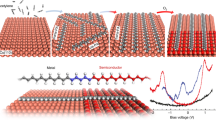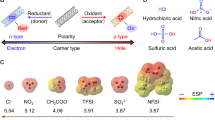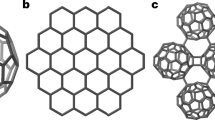Abstract
THE recent syntheses1,2 of macroscopic quantities of C60 have suggested possible applications in host–guest and organic chemistry, tribology, electrochemistry and semiconductor tech-nology. Here we report the preparation of alkali-metal-doped films of C60 and C70 which have electrical conductivities at room temperature that are comparable to those attained by n-type doped polyacetylene. The highest conductivities observed in the doped films are: 4Scm−1 (Cs/C60), 100 (Rb/C60), 500 (K/C60), 20 (Na/C60), 10 (Li/C60), 2 (K/C70). The doping process is reversed on exposure of the films to the atmosphere. At high doping levels, the films become more resistive. We attribute the conductivity induced in these films to the formation of energy bands from the π orbitals of C60 or C70, which become partially filled with carriers on doping. The smaller alkali metal ions should be able to fit into the interstices in the lattice without disrupting the network of contacts between the carbon spheroids. In the case of C60, this would allow the development of an isotropic band structure, and we therefore propose that these materials may constitute the first three-dimensional 'organic' conductors.
This is a preview of subscription content, access via your institution
Access options
Subscribe to this journal
Receive 51 print issues and online access
$199.00 per year
only $3.90 per issue
Buy this article
- Purchase on Springer Link
- Instant access to full article PDF
Prices may be subject to local taxes which are calculated during checkout
Similar content being viewed by others
References
Kratschmer, W., Lamb, L. D., Fostiropoulos, K. & Huffman, D. R. Nature 347, 354–358 (1990).
Meijer, G. & Bethune, D. S. J. chem. Phys. 93, 7800–7802 (1990).
Skotheim, T. A. (ed.) Handbook of Conductive Polymers (Marcel Dekker, New York, 1986).
Ferraro, J. R. & Williams, J. M. Introduction to Synthetic Electrical Conductors (Academic, London, 1987).
Legrand, A. P. & Flandrois, S. (eds) Chemical Physics of Intercalation (Plenum, New York, 1987).
Ishiguro, T. & Yamaji, K. Organic Superconductors (Springer, Berlin, 1990).
Haddon, R. C., Brus, L. E. & Raghavachari, K. Chem. Phys. Lett. 125, 459–464 (1986).
Curl, R. F. & Smalley, R. E. Science 242, 1017–1022 (1988).
Hauffler, R. E. et al. J. phys. Chem. 94, 8634–8636 (1990).
Allemand, P.-M. et al. J. Am. chem. Soc. 113, 1050–1051 (1991).
Kroto, H. W., Heath, J. R., O'Brien, S. C., Curl, R. F. & Smalley, R. E. Nature 318, 162–164 (1985).
Fleming, R. M. et al. Proc. Mat. Res. Soc. Symp. G Boston, 1990 (in the press).
Allemand, P.-M. et al. J. Am. chem. Soc. (in the press).
Bethune, D. S., Meijer, G., Tang, W. C. & Rosen, H. J. Chem. Phys. Lett 174, 219–222 (1990).
Nemanich, R. J., Solin, S. A. & Guerard, D. Phys. Rev. B 16, 2965–2972 (1977).
Garrell, R. L. et al. J. Am. chem. Soc. (submitted).
Haddon, R. C. Acc. Chem. Res. 21, 243–249 (1988).
Author information
Authors and Affiliations
Rights and permissions
About this article
Cite this article
Haddon, R., Hebard, A., Rosseinsky, M. et al. Conducting films of C60 and C70 by alkali-metal doping. Nature 350, 320–322 (1991). https://doi.org/10.1038/350320a0
Received:
Accepted:
Issue Date:
DOI: https://doi.org/10.1038/350320a0
Comments
By submitting a comment you agree to abide by our Terms and Community Guidelines. If you find something abusive or that does not comply with our terms or guidelines please flag it as inappropriate.



